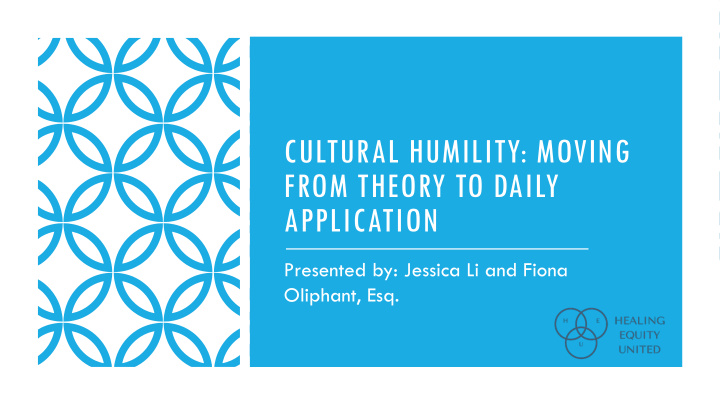



CULTURAL HUMILITY: MOVING FROM THEORY TO DAILY APPLICATION Presented by: Jessica Li and Fiona Oliphant, Esq.
GET TO KNOW US
GET TO KNOW US
1. To establish a common understanding of how identity, oppression, and privilege affects us and impacts our work as advocates and/or survivors. 2. To define the distinction between Cultural Humility and Cultural Competency so that we OBJECTIVES may be better equipped to engage and serve survivors from marginalized communities. 3. To identify how a Cultural Humility framework may be utilized to conduct an organizational assessment and thereby strategically enhance service provision for sexual violence survivors.
-There’s no room for the oppression Olympics in this space GROUP AGREEMENTS -Expect and accept challenging CONTINUED moments -Practice engaged listening
-Step up, step aside -Respect different lived experiences and perspectives GROUP AGREEMENTS -Focus on your own learning -Address the group not an individual -Take care of yourself
THE TRUE FOCUS OF REVOLUTIONARY CHANGE IS TO SEE THE PIECE OF THE OPPRESSOR INSIDE US. -AUDRE LOURDE
Race Sexual Orientation Ability WHAT’S YOUR IDENTITY? Religion Gender Class Sex
Margins MARGINS/MAIN STREAM
A system that maintains advantage and disadvantage based on social group OPPRESSION memberships and operates, intentionally and unintentionally, on individual, institutional and cultural levels.
Omnipresent Confining OPPRESSION’S CHARACTERISTICS Hierarchical Multifaceted
Ableism Ageism FORMS OF Classism OPPRESSION Heterosexism Racism Sexism
OPPRESSION MATRIX Privileged -ism Impact Social Targeted Groups Identity Groups ? ? ? ? Race Sex Gender Sexual Orientation Class Ability Religion Age
Advantages and benefits afforded to certain people PRIVILEGE based on their group identity or status.
PRIVILEGE & POWER ACTIVITY
A FRAMEWORK FOR CULTURAL HUMILITY
WHAT NARRATIVES WOULD YOU CREATE IF ONE OF THEM WERE YOUR CLIENT?
CULTURAL HUMILITY REQUIRES RECOGNIZING MORE THAN WHAT LIES ABOVE THE SURFACE
WHAT IS CULTURE?
A set of shared experiences or commonalities that have developed and continue to evolve within a group of CULTURE IS: people according to changing social and political contexts.
CULTURAL COMPETENCY VS. CULTURAL HUMILITY
Lifelong process of critical self- refection. ELEMENTS OF Mitigate power imbalances. CULTURAL HUMILITY Accountability. Develop respectful partnerships.
BE CURIOUS BE UNCOMFORTABLE BE VULNERABLE
-Promote Cultural Relevance -Update policies and procedures to be more accessible DAY-TO-DAY -Provide sustained training and support APPLICATION for staff -Build trusted relationships -Partnering with culturally specific organizations
-Organizational Culture -Environment CONDUCT AN -Materials ORGANIZATIONAL -Policies AUDIT -Current populations served -Target population reflected on staff and leadership
1. What are some steps that you can take individually to implement Cultural Humility? 2. What are some strategies that your SMALL GROUP organization can implement to foster an DISCUSSION environment of Cultural Humility? 3. What can you do to foster culture change within your organization with or without leadership’s support and commitment?
QUESTIONS JESSICA@HEALINGEQUITYUNITED.COM FIONA@HEALINGEQUITYUNITED.COM
Recommend
More recommend